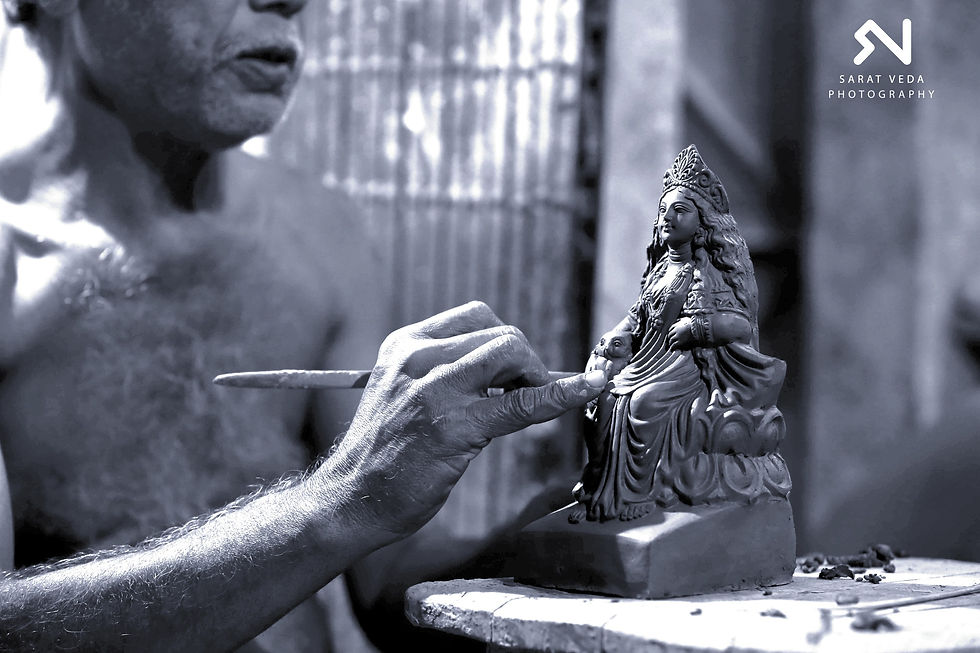Being a travel photographer it was always my dream to shoot Kolkata- the city of Joy. From my perspective the streets, monuments, people, traditions and the over all ambience had a unique visual charisma and plenty of stories behind them.

Kolkata is indeed a land of amiable contrasts where the tranquilness of a rich colonial heritage blends with the swiftness of a vibrant metropolitan city.

The cultural diversity of Kolkata had been a fascination for me ever since my schooldays. I was always captivated by the visuals of durga puja, pandals with blazing lights, flickering clay lamps, huge processions, men in stiff dhotis, dancing women in starched cotton saris and all apart, the sight of Durga Ma in all her resplendency.

The attractive part is that the preparation of durga puja begins months before, with artisans toiling day and night to mould and shape the idols. It is said that over 15,000 idols are made each year and my query to from where all these idols come from lead me to the lively streets of Kumartuli, located in north Kolkata on the banks of river Hooghly.
I decided to capture the life of kumartuli in action on my visit.


The term “Kumar” indicates potter. It is a 250 year old idol making centre of Kolkata where potters make clay idols for all sorts of indian festivals including durga puja, saraswati puja, lakshmi puja , kali puja and ganeshotsav. The master artisans reside on the twisty lanes and bye lanes of neighbouring shobha bazaar and Banamali Sarkar Street.

On first look the activities appear to be a part of local household occupation but in reality it is a business hub where the idols made are traded all over India and is even exported to many countries.
The creative sculpting is ancestral legacy and most families have their third and fourth generations running the business.

I had a brief chat with Bhola running his family business in a single room shop with his son to help him out. He inherited it from his father and even though not a profitable business now he is proud and honoured to continue the tradition and has passed his skills to his son too. He explained me the intricacies involved in the procedures and briefed about how his ancestors sweated out to establish their family legacy.


The holy mix of clay used for making the idols is taken from Hoogly river bed (Ganga Matti) along with cow dung and cow urine. An integral part of the combination is mud from area where prostitutes lives (vaishya matti). As per the words of a priest the most auspicious method of soil collection is to beg it from a prostitute and have her hand it to you as a gift or a blessing. As said, the reason behind this custom is to let the otherwise shunned members get involved with the society and to cleanse prostitutes of their sins. But this tradition is getting a stiff opposition from the sex workers as they blame the society for the ill treatment they receive rest of the year.

The skeletal frame work of the idol is made from bamboo and is shaped by hay. It is then covered with clay and it takes around three weeks to complete the drying process.

He welcomed me for a local pooja being held the next day and directed me to a bye lane nearby where an auspicious part of idol completion was being done. It is called as chakkhu daan – means painting the eye of the idol. The sight of muddy hands involved in creation was never ending as I went deeper through the narrow lanes towards the idol.

At the end of the lane I found an almost 10 foot high idol of the goddess about completion, with the final painting works going on. I was happy and felt blessed to witness the auspicious chakkhu daan ceremony and thanked Bhola whole heartedly for his help.

I was greatly humbled by his generosity and I felt it was only this divine profession that moulded his noble character.
Bhola is just one among the stakeholders of this tradition and I found many more persons indulged in creation in crammed rooms under the dim light work space.

This includes a large number of women artisans too who had taken up the profession due to their own reasons. I felt each one of them had a string of stories to tell from their experiences all through the years. It was not just a profession for them but something much beyond, entwining them physically and emotionally.


The artisans of Kumartoli impressed me with the way they were sticking to their tradition with at most passion and dedication. They live in the present not worrying about what future leads to, keeping their faith and trust on what they create.. the powerful hands of goddess shakti..

Thank You...


Awesome clicks
nice blog